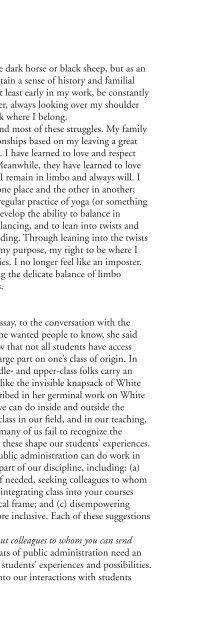WINTER 2012 - National Association of Schools of Public Affairs and ...
WINTER 2012 - National Association of Schools of Public Affairs and ...
WINTER 2012 - National Association of Schools of Public Affairs and ...
Create successful ePaper yourself
Turn your PDF publications into a flip-book with our unique Google optimized e-Paper software.
Techniques in Teaching Statistics<br />
Lastly, the anxiety-<strong>and</strong>-motivation loop (R4) captures the interaction <strong>of</strong><br />
skill development, anxiety, <strong>and</strong> motivation <strong>of</strong> students. In this loop, we see<br />
that as quantitative skills increase, the level <strong>of</strong> anxiety about statistics decreases,<br />
bringing student motivation, participation, <strong>and</strong> engagement up. As motivation<br />
grows, further increased levels <strong>of</strong> practitioner quantitative skills are achieved.<br />
The reinforcing process just depicted can become either an engine <strong>of</strong> success<br />
or a vicious cycle <strong>of</strong> failure. To deactivate the possibility <strong>of</strong> being locked into<br />
a downward spiral <strong>of</strong> high anxiety <strong>and</strong> low motivation, dealing with the<br />
quantitative underpreparedness <strong>of</strong> students, making use <strong>of</strong> relevant real-life<br />
applications, <strong>and</strong> developing student-centric considerations may be useful.<br />
DISCUSSION<br />
Returning to the initial motivation <strong>of</strong> this study, we want to work toward<br />
shrinking the research-practice gap by examining factors that influence<br />
the consumption <strong>of</strong> research by practitioners—in particular, the ability to<br />
comprehend <strong>and</strong> employ statistical techniques.<br />
If closing the research practice gap is important, then reflecting on <strong>and</strong><br />
improving statistics instruction seems desirable. The development <strong>of</strong> practitioner<br />
statistics skills in the classroom is constrained by anxiety about statistics,<br />
quantitative underpreparedness, student desire to memorize rather than<br />
underst<strong>and</strong>, challenges in developing tools that are effective for learning, <strong>and</strong><br />
general lack <strong>of</strong> student motivation, participation, <strong>and</strong> engagement. By addressing<br />
these challenges with teaching techniques such as making interpretation rather<br />
than results a priority, using relevant real-life examples, requiring data collection<br />
exercises, employing computer applications, <strong>and</strong> so on, we may increase<br />
practitioner statistical skills. Increased practitioner statistical skills will, in turn,<br />
lead to increased research use. Increased research use then will lead to an increase<br />
in relevant, high-quality research production <strong>and</strong> thus shrink the researchpractice<br />
gap.<br />
Viewing the challenges associated with teaching statistics from a systems<br />
perspective is valuable. Underst<strong>and</strong>ing how one challenge may influence other<br />
challenges is useful when considering tools <strong>and</strong> techniques for addressing<br />
such challenges. So, for example, coming up with ways to address quantitative<br />
underpreparedness before taking a statistics course may serve to reduce anxiety;<br />
increase motivation, participation, <strong>and</strong> engagement; <strong>and</strong> ultimately result in an<br />
increase in practitioner quantitative skills. In addition, designing tools effective<br />
for learning will increase practitioner quantitative skills. Such tools will also<br />
decrease student desire to memorize, not underst<strong>and</strong>, <strong>and</strong> this attitude in turn<br />
will increase practitioner quantitative skills.<br />
A broader point that can be derived from this thinking is that to increase<br />
the likelihood <strong>of</strong> successfully addressing the research-practice gap, the use <strong>of</strong> a<br />
systems approach seems warranted. Part <strong>of</strong> the model <strong>of</strong> research production <strong>and</strong><br />
Journal <strong>of</strong> <strong>Public</strong> <strong>Affairs</strong> Education 129

















